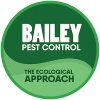Wasp nests are a problem because as you know, they can contain up to 10,000 wasps!
Obviously a wasp’s nest doesn’t just appear. It takes a whole summer of building. So here’s a quick guide to help you spot you’ve got a wasp nest being built in your property.
Where Do Wasps Build Their Nests?
The bad news is that a wasp colony never reuses a nest. At the end of the summer, the nest is abandoned by all but the Queen wasp, who stays and hibernates until the next spring. She will then go in search of a new location in which to build her new nest.
The Queen wasp will start building her new nest in anywhere from wall cavities, roof voids or outbuildings. Unfortunately for those of you that live in Sussex, places like Brighton have these in obundance!
What Are Wasp Nests Built From?
Paper-making wasps like yellowjackets and white-faced black hornets have powerful enough jaws to bite and pull off little chunks of wood from fences and other boards. The wood reacts with the wasp’s saliva, softening and turning into a pastey pulp. At the nest site, the wasp releases the pulp and uses its front feet to pat the pulp like a putty onto the nest in careful layers.
Wasp Nest Architecture
The wasps make the outside of the nest harder, like a shell. This part is waterproof. Inside are rows of little individual oval cells stacked on top of each other like apartments in a high-rise building. Each layer connects to a strong vertical core that attaches at the top to the branch or beam from which the whole nest hangs. Each cell opens on the same side and slants down. The door to the whole nest is always a hole at the bottom.
Wasp Nest Form Follows Function
The queen wasp lays one egg in each cell of the nest. It sticks to the paper so even with the downward slant of the cell’s opening, the egg won’t fall out. The larvae hatch and stay put in the cells. They don’t fall out, either, because they have a sticky back end that keeps them in. They put out their heads so that the worker wasps will feed them. When a nest needs to get bigger, the wasps cut a section of the interior paper and then attach new sections to the outside.
How To Spot A Wasp Nest
In the beginning, the wasp’s nest is only about the size of a golf ball or a tennis ball. The outside is covered with swirling patterns, probably caused by the wasps as they move over the structure.
As the nest can be so small, it is often difficult to spot it on its own. The best way to determine if there’s a wasp’s nest in your property is to spot the wasps.
Take a very slow walk around your property looking for wasps going in and out of a single entrance hole every 2-4 seconds. This will indicate a nest 4-6 inches behind this hole.
What Do You Do If You Spot A Wasp’s Nest?
Bearing in mind there could be a couple of thousand wasps in there, you shouldn’t go prodding around. The last thing you want is to disturb the nest and encourage the wasps to start defending their position with stings!
Instead, call us for a free site survey and we’ll show you how to remove your wasp problem safely and quickly.

